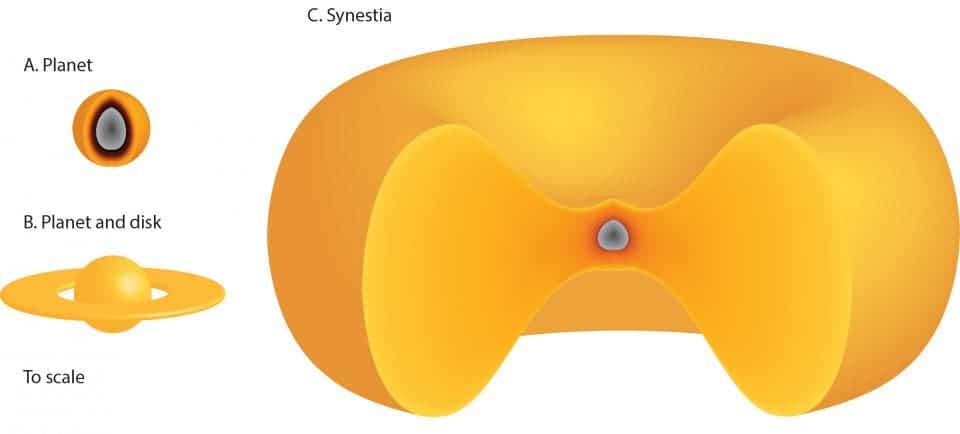A pair of physicists is proposing a new type of planetary body: the donut-shaped body of vaporized and molten rock called a synestia. This kind of planetary body is predicted to form under certain conditions when planet-sized objects collide into each other with high energy and angular momentum. It’s possible Earth went through an intermediate synestia state before the vaporized gas and dust condensed into the spherical bundle of joy we all know and love.
The novel planetary body — the third after ‘planet’ and ‘planet and disk’, i.e. Saturn — was first described by Simon Lock, a graduate student at Harvard, and Sarah Stewart, professor of planetary science at the University of California, Davis. Both researchers are academically focused on studying what happens when planet-sized objects smash into each other. Particularly, the two are interested in what happens during the collisions of massive spinning objects.
Any rotating object has an angular momentum which needs to stay conserved. The law of conservation of angular momentum states that when no external torque acts on an object, no change of angular momentum will occur. If the net torque is zero, then angular momentum is constant or conserved.
It’s the conservation of angular momentum that can explain why an ice skater can increase the angular acceleration by bringing her arms and legs close to the vertical axis of rotation. Because the moment is conserved, when the skater decreases rotational inertia, the rotation rate must increase. Ultimately, the skater’s angular momentum is the same. And when two ice skaters catch hold of each other, the angular momentum of each skater adds up — again, per the law of conservation of angular momentum, the summed angular momentum must remain the same.
And as a nice bit of trivia, it’s because of this law that the solar system is flat.
Now, imagine what happens when your two skaters are actually two planets that crash into each other. When Lock and Stewart modeled what happened to Earth-sized rocky planets after a collision with other large objects over a range of high temperatures and high angular momentum, they found a completely new planetary structure. They have dubbed the new object a “synestia,” from “syn-,” “together” and “Hestia,” Greek goddess of architecture and structures.
To understand how a synestia can form, you need to again imagine what happens during a giant impact. To make things easier, take our planet — Earth. More than 4.5 billion years ago, a proto-Earth and a Mars-sized body called Theia collided. In the wake of this cosmic crash, Earth and its moon were formed. We’re certain of this because the isotopic compositions of a variety of elements collected from both terrestrial and lunar rocks are nearly identical. What’s not very clear is how exactly all this hot tango danced out.
What’s perhaps the most convincing Earth-formation theory so far was published in September, 2016, and argues that following the collision both bodies became completely vaporized. Since the result of the giant impact is molten or gaseous, its volume will be higher than the combined volume of the two planetary bodies. If this mass gets big enough and is moving fast enough — if the conserved momentum is big enough in other words — it can then form this huge, disk-shape synestia. And this object would be much larger than a solid planet with a disk.
According to Stewart, most planets experienced collisions that formed a synestia at some point in their history. In the case of Earth, if this ever happened, the synestia must not have lasted for very long — perhaps only a hundred years.
Nevertheless, no one has yet observed a synestia directly — it’s still a theoretical oddity. After the James Webb Telescope is launched in space in late 2018, we might get the chance once astronomers set the instruments’ gaze towards rocky exoplanets and gas giants outside our solar system.
The findings appeared in the Journal of Geophysical Research: Planets.











